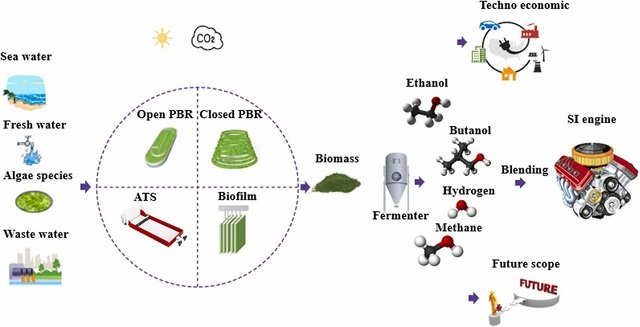USA.- The genome of the fuel-producing green microalga Botryococcus braunii has been sequenced by a team of researchers led by a group at Texas A&M AgriLife Research.
The report, in Genome Announcements, comes after almost seven years of research, according to Dr. Tim Devarenne, AgriLife Research biochemist and principal investigator in College Station. In addition to sequencing the genome, other genetic facts emerged that ultimately could help his team and others studying this green microalga further research toward producing algae and plants as a renewable fuel source.
“This alga is colony-forming, which means that a lot of individual cells grow to form a colony. These cells make lots of hydrocarbons and then export them into an extracellular matrix for storage,” Devarenne said. “And these hydrocarbons can be converted into fuels – gasoline, kerosene and diesel, for example, the same way that one converts petroleum into these fuels.”
Devarenne pointed to previous studies showing that hydrocarbons from B. braunii have long been associated with petroleum deposits, indicating that over geologic time the alga has coincided with and contributed to the formation of petroleum deposits.
“Essentially, if we were to use the hydrocarbon oils from this alga to be a renewable fuel source, there would be no need to change any kind of infrastructure for making the fuel. It could be put right into the existing petroleum processing system and get the same fuels out of it,” he said.
Devarenne said his lab wants to understand not so much how to make fuel, but rather how the alga makes these hydrocarbons, what genes and enzymes are involved and how they function.
“Once we understand that, maybe we can manipulate the alga to make more oil or specific types of oil or maybe we can transfer those genes into other photosynthetic organisms to have them make the oil instead of the alga,” said Devarenne, whose lab in 2016 announced the discovery of the enzyme used by the algae to produce hydrocarbons.
That’s why sequencing the genome was important, he said, because it will help identify all the genes and enzymes in the genome needed for hydrocarbon production and control of this production.
Stay Always Informed
Join our communities to instantly receive the most important news, reports, and analysis from the aquaculture industry.
And it isn’t easy. Sequencing the genome means isolating all the DNA from the nucleus of the cell, sequencing it into small fragments and then assembling it back together into a complete genome. Think of a 166 million-piece jigsaw puzzle, given that the size of the B. braunii genome is estimated to be about 166 million bases, he said.
Devarenne said that because only portions of the B. braunii genome in this report are “spelled out,” so to speak, it is considered a draft genome, or first attempt at assembling all the pieces.
“It’s not perfect, but it’s still very usable and valuable to the other researchers who are studying this alga,” he said. His own lab plans to do a more in-depth analysis and compare it to other known algae and land plant genomes so as to see what’s unique and similar.
Along with the sequencing, Devarenne’s study found that there are about 18,500 genes in the B. braunii genome and there are portions of genes called untranslated regions that are very long. These regions are not formed into proteins but are rather used for regulatory purposes.
“They can be several thousand base pairs long, whereas in most organisms those regions may be only a couple hundred base pairs long,” he said of the untranslated regions. “We don’t know what that’s about yet.”
He said the B. braunii genome has been very challenging to assemble because of lots of repetitive sequences in it.
“Assembling the genome is not a trivial process at all,” Devarenne explained. “We send DNA to be sequenced by the Joint Genome Institute, which is part of the U.S. Department of Energy, and they sequence it in lots of very small fragments. These fragments of DNA may be anywhere from 150 to 300 base pairs long. So imagine if we have 166 million bases in our genome, and it is sent back to us in little fragments that have to be assembled back together to arrive at 166 million bases. We used the Texas A&M Supercomputer Center to help.”
As more gaps are filled in, he said, a more complete genome will emerge, and that will help researchers dive deeper into the biochemical processes in this alga.That information will then help them understand how and why the organism makes hydrocarbons in very high quantities, how that process is regulated and what the particular biosynthetic pathways are used to make the hydrocarbons.
“Just like the human genome has been sequenced but isn’t fully understood, there is still a lot to study. It’s really a never-ending process,” Devarenne said.
Contact:
Dr. Tim Devarenne
Telf.: 979-862-6509
Email: tpd8@tamu.edu
Reference (open):
Browne DR, Jenkins J, Schmutz J, Shu S, Barry K, Grimwood J, Chiniquy J, Sharma A, Niehaus TD, Weiss TL, Koppisch AT, Fox DT, Dhungana S, Okada S, Chappell J, Devarenne TP. 2017. Draft nuclear genome sequence of the liquid hydrocarbon–accumulating green microalga Botryococcus braunii race B (Showa). Genome Announc 5:e00215-17. https://doi.org/10.1128/genomeA.00215-17.
http://genomea.asm.org/content/5/16/e00215-17.full.pdf
Editor at the digital magazine AquaHoy. He holds a degree in Aquaculture Biology from the National University of Santa (UNS) and a Master’s degree in Science and Innovation Management from the Polytechnic University of Valencia, with postgraduate diplomas in Business Innovation and Innovation Management. He possesses extensive experience in the aquaculture and fisheries sector, having led the Fisheries Innovation Unit of the National Program for Innovation in Fisheries and Aquaculture (PNIPA). He has served as a senior consultant in technology watch, an innovation project formulator and advisor, and a lecturer at UNS. He is a member of the Peruvian College of Biologists and was recognized by the World Aquaculture Society (WAS) in 2016 for his contribution to aquaculture.




